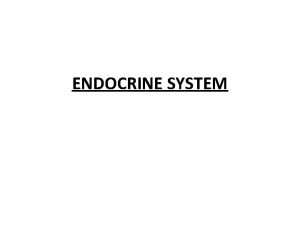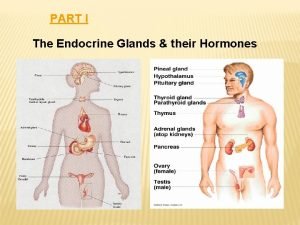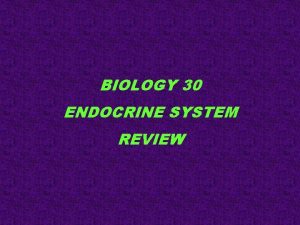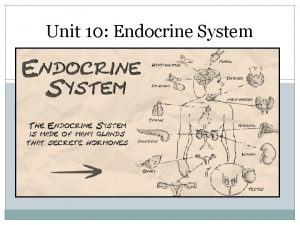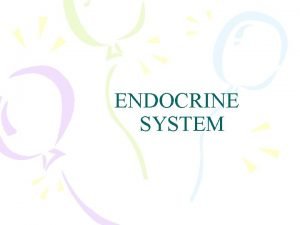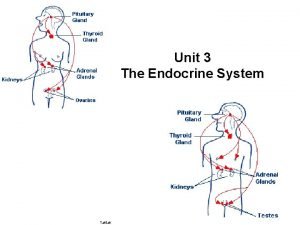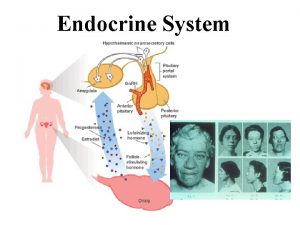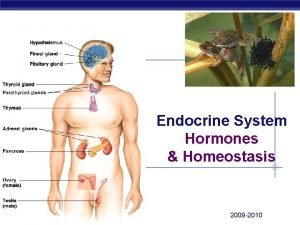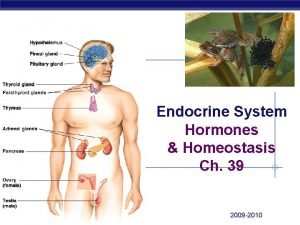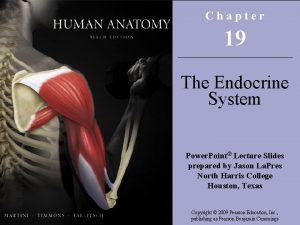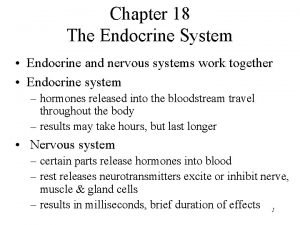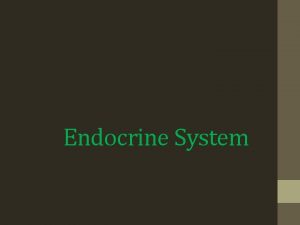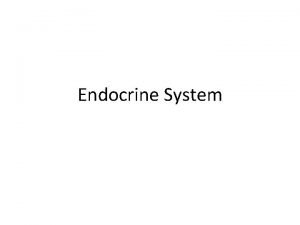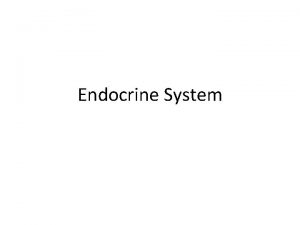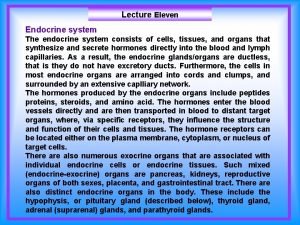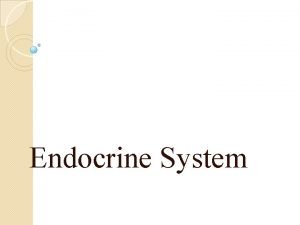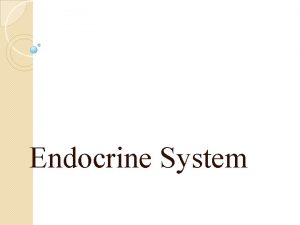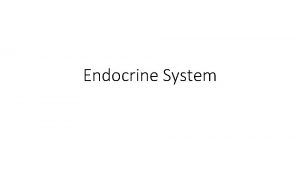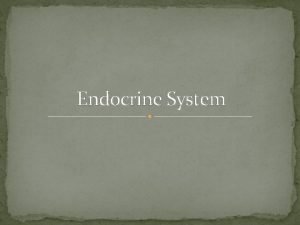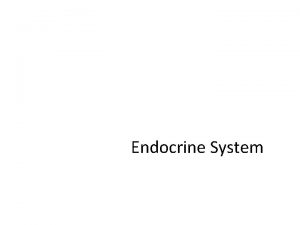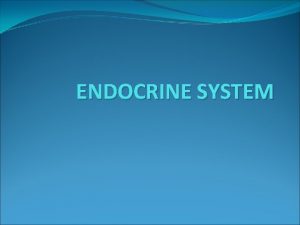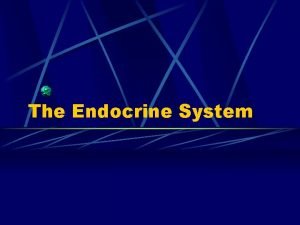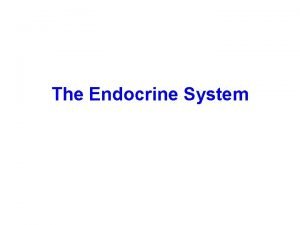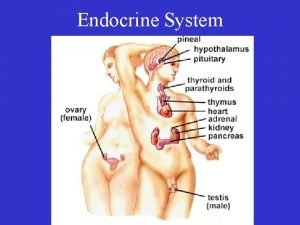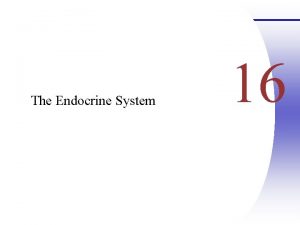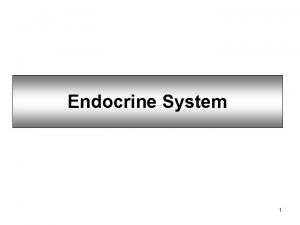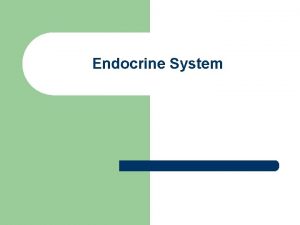Endocrine System The Endocrine System Consists of several








































- Slides: 40

Endocrine System

The Endocrine System • Consists of several glands located in various parts of the body • Specific Glands – – – – – Hypothalamus Pituitary Thyroid Parathyroid Adrenal Kidneys Pancreatic Islets Ovaries Testes

Thyroid Gland • The thyroid gland is located on the front part of the neck below the thyroid cartilage (Adam's apple). Gross section of normal thyroid gland

Thyroid gland function Thyroid gland produces thyroid hormones: • Thyroxin (T 4) , and triiodothyronine(T 3) are important in: • growth • development • maintaining normal body temperature • energy metabolism regulation • Stimulate metabolism of all cells • Calcitonin Decreases blood calcium concentration by inhibiting breakdown of bone *The thyroid gland uses from the diet in foods such as seafood, bread, and salt) to produce thyroid hormones

The hypothalamus releases a thyroid releasing hormone (TRH), which sends a signal to the pituitary to release thyroid stimulating hormone (TSH), (TSH, a pituitary hormone) modulates thyroid function by binding to TSH receptors (TSH-R) and sends a signal to the thyroid to release thyroid hormones. T 4&T 3


Hyperthyroidism case presentation • A 37 -year-old female presents to your clinic with a three week history of palpitations, feeling hot all the time, anxiety , weigh loss, increased appetite and oligomenorrhea. • On physical examination • Patient has diffuse goiter (enlarged thyroid gland) • Palpitation • Tremor(involuntary movements and can affect the hands, arms, head, face, vocal cords, trunk, and legs) • What do you think the patients primary problem is?

Hyperthyroidism • Hyperthyroidism (overactive thyroid gland): thyroid gland produces and secretes excessive amounts of thyroid hormones, riiodothyronine (T 3) and thyroxine (T 4).

Hyperthyroidism Clinical Manifestations • • What signs might you find on exam? diffuse goiter (enlarged thyroid gland) weight loss (often accompanied by an increased appetite intolerance to heat tremor Rapid or irregular heartbeat (palpitations or arrhythmia) hyperactivity, restlessness and difficulty sleeping Frequent bowel movements sweating Nervousness weakness, fatigue menstrual irregularities in women or amenorrhea • nausea, vomiting • diarrhea • •

Hyperthyroidism • What is the initial test you need it to confirmed the diagnosis? Diagnosis • Blood tests to measure levels of TSH , total and free T 3 and T 4( TT 3, FT 3, TT 4, FT 4) • Radioactive iodine uptake and scan • CT scan or ultrasound • FNA in thyroid cancer

Hyperthyroidism • What Causes Hyperthyroidism? • There is many causes • Graves’ disease is the most common cause of hyperthyroidism and thyrotoxicosis

Hyperthyroidism • The test results of the patient show • TSH , T 4 , T 3 • Confirmed that the patient has hyperthyroidism Is the patent has hyperthyroidism caused by Graves disease ? ! • what additional tests would you order?

Graves disease • Graves' Disease is an autoimmune condition in which autoantibodies are directed against the thyroid-stimulating hormone (TSH) receptor. • lead to stimulate the production of thyroid hormones, thyroxin (T 4)and triiodothyronine(T 3) • the autoantibodies are not under a negative feedback control system lead to overproduction of the thyroid hormones (hyper thyrpdisim) many metabolic problems.


Graves disease Risk factors: • is most common in women over age 20. • White and Asian populations are at higher risk than black populations • The disease is more common in female more than male • family history of thyroid disease and Genetic factors • Smoking is also a significant risk factor

Graves disease symptoms • Patients with Graves' disease can exhibit a variety of symptoms related to hyperthyroidism • some patients with Graves' disease exhibit unique symptoms including: • (bulging eyes) • pretibial myxedema (swelling of legs ) • Graves' disease is often called diffuse toxic goiter because the entire thyroid gland is enlarged.

Graves’ disease Bulging eyes weight loss Tremor heart Palpitation pretibial myxedema

Thyroid goiter : is enlargement of thyroid gland can be present in hyperthyroidism disorders as well as in hypothyroidism disorders

Hyperthyroidism Graves’ disease patient with Graves disease show Bulging eyes

Graves disease Bulging eyes Thyroid goiter Patient with Graves’ disease show bulging eyes and diffuse goiter (enlarged thyroid gland)

Graves disease : pretibial myxedema

Graves disease Diffuse toxic goiter of Graves disease, gross, showing symmetric, non-nodular hypervascular enlargement of the thyroid

Graves disease Diagnosis • Anti-TSH receptor antibody: (TRABs) are specific test for Graves’ disease

Hyperthyroidism Treatment : • Antithyroid medications • Radioactive iodine (which destroys the thyroid and stops the excess production of hormones) • Surgery to remove thyroid • If the thyroid must be removed with surgery or destroyed with radiation, the patient must take thyroid hormone replacement pills for the rest of his life.

Hypothyroidism case study presentation • A 46 -year-old female presents with a 6 -month history of fatigue, constipation, menorrhagia, cold intolerance , loss of pitied and weight gaining. She mentions incidentally that her mother has “thyroid” problems. • What is the probably diagnosis? Hypothyroidism

Hypothyroidism What is hypothyroidism? hypothyroidism : is low production of thyroid hormone (T 4), (T 3). Myxedema : is hypothyroidism but in its extreme form

Hypothyroidism What are the symptoms of hypothyroidism? Clinical manifestation: • Enlarged neck or presence • of goiter • • intolerance to cold • • weight gain • • Increased blood cholesterol • • Poor memory • • Nigh blindness • Heavy and irregular periods Sleepiness constipation dry skin droopy eyelids puffy and swollen face slowing of the heart rate

Hypothyroidism

Buffy dull face with dray skin The patient with severe hypothyroidism (myxedema) has a dull, puffy facies. The edema, often particularly pronounced around the eyes, (periorbital edema )does not pit with pressure. The hair and eyebrows are dry, coarse, and thinned. The skin is dry.

hypothyroidism

Hypothyroidism two cases of hypothyroidism, patient before (A and C) and after (B and D) after full replacement with thyroid hormone recovered from hypothyroidism. In fig A, Notice the loss of eyelashes, the areas of vitiligo around the mouth, the region around the eyes, and the scalp. In figure-C, Notice the lethargic expression and the periorbital puffiness disappears with therapy (D).

Hypothyroidism What causes hypothyroidism? Causes: • Hashimoto’s disease • Thyroid destruction (from radioactive iodine or surgery , infections ) • Pituitary or hypothalamic disease • Medications • Severe iodine deficiency

Hypothyroidism How is hypothyroidism diagnosed? Measuring blood levels of thyroid (T 4, T 3) hormones TSH blood concentration. The lab analysis show: blood levels of thyroid (T 4, T 3) decreased. TSH blood concentration increased ( high) the lab analysis confirmed the patient has hypothyroidism • Is the patient has Hashimoto’s disease ? ! • •

Hashimoto’s disease • What is the Hashimoto’s disease? • Hashimoto's (chronic thyroiditis is) an autoimmune disorder directed against thyroid antigens and is the most common cause of hypothyroidism. • how can be confirmed if the patient has Hashimoto’s disease? by thyroid peroxidase (anti-TPO antibodies) concentration. • Hashimoto's can be identified by detecting anti. TPO antibodies in the blood

Hypothyroidism (Right) Struma lymphomatosa in Hashimoto thyroiditis, gross. Note: diffuse, pale yellow infiltrate affecting the entire thyroid. The yellow infiltrate is caused by an influx of lymphocytes, which may form follicles. Normal thyroid (Left)

Hypothyroidism • How is hypothyroidism treated? • receive thyroid hormone replacement therapy

Hashimoto’ disease Graves’s disease During Hashimoto's thyroiditis, self-reactive CD 4+ T lymphocytes recruit B cells and CD 8+ T cells into the thyroid. Disease progression leads to the death of thyroid cells and hypothyroidism. Both autoantibodies and thyroid-specific cytotoxic T lymphocytes (CTLs) have been proposed to be responsible for autoimmune thyrocyte depletion. b | In Graves' disease, activated CD 4+ T cells induce B cells to secrete thyroid-stimulating immunoglobulins (TSI) against the thyroid-stimulating hormone receptor (TSHR), resulting in unrestrained thyroid hormone production and hyperthyroidism

Case study • A 51 -year-old woman presented with weight loss (despite good appetite), palpitations, tremor, and heat intolerance. • On examination, she had diffusely enlarged thyroid, periorbital edema, and proptosis, as well as mild thickening of the skin in the pretibial area.

Case study (1) • The lab results of thyroid-function tests: • (TSH) thyroid-stimulating hormone level : • 0. 1 m. U /ml < (normal range, 0. 5 to 5. 15) • (T 3) triiodothyronine level: 557 ng/dl normal range, 100 to 190 ng /dl • (T 4 )thyroxine level • 17. 9 μg /dl (normal range, 4. 4 to 12. 5 μg/dl) • Anti-TSH receptor antibodies 69. 6 %. (normal range (0. 0 to 16. 0 Unit: %)

Case study (1) • What is the diagnosis ? • Hyperthyroidism What is the cause of hyperthyroidism, and why ? • Graves disease • because the patient has Anti-TSH receptor antibodies
 Endocrine system introduction
Endocrine system introduction Endocrine system and reproductive system
Endocrine system and reproductive system Endocrine system vs nervous system
Endocrine system vs nervous system Lympathic
Lympathic Amino acid-based hormones
Amino acid-based hormones Endocrine system and nervous system
Endocrine system and nervous system Endocrine
Endocrine Adenohypophysis
Adenohypophysis Differences between nervous system and endocrine
Differences between nervous system and endocrine Comparison of endocrine and nervous system
Comparison of endocrine and nervous system Endocrine molecules
Endocrine molecules Endocrine system fact
Endocrine system fact Rat urinary system
Rat urinary system Oxication
Oxication Metabolic action of growth hormone
Metabolic action of growth hormone Endocrine and nervous system comparison
Endocrine and nervous system comparison 7:13 endocrine system
7:13 endocrine system Stimulus endocrine system
Stimulus endocrine system Figure of endocrine system
Figure of endocrine system Chapter 11 endocrine system
Chapter 11 endocrine system Biology 30 endocrine system
Biology 30 endocrine system Gonads glands
Gonads glands Chapter 23 the endocrine system
Chapter 23 the endocrine system Endocrine system analogy
Endocrine system analogy Classification of hormones
Classification of hormones T3.taktak
T3.taktak Endocrine system
Endocrine system Classification of hormone
Classification of hormone Pancreas in endocrine system
Pancreas in endocrine system Glands of the endocrine system
Glands of the endocrine system Endocrine system
Endocrine system Chapter 16 lesson 1 the endocrine system
Chapter 16 lesson 1 the endocrine system Endocrine system regents questions
Endocrine system regents questions Endocrine system regents questions
Endocrine system regents questions Hormones
Hormones Endocrine tissues
Endocrine tissues What are the lipid soluble hormones
What are the lipid soluble hormones Hình ảnh bộ gõ cơ thể búng tay
Hình ảnh bộ gõ cơ thể búng tay Bổ thể
Bổ thể Tỉ lệ cơ thể trẻ em
Tỉ lệ cơ thể trẻ em
